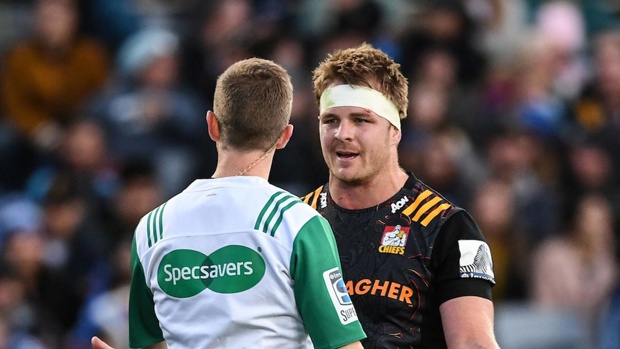How Super Rugby Aotearoa's two new rules will work
- Publish Date
- Wednesday, 10 February 2021, 9:03AM

Photosport
Goal line drop outs and a captain's challenge have been announced for Super Rugby Aotearoa, just weeks out from the competition start.
The two league-style innovations will make their debut when Super Rugby trial matches are played this weekend. The competition starts a fortnight later.
Captains will have 10 seconds after a try is scored to challenge anything since the last stoppage.
But from the 75th minute, they can make a challenge whether a try is scored or not. Alleged foul play can be challenged at any time throughout a match.
An incorrect challenge at any point of the game means all future challenge opportunities are lost.
While the challenge system could heavily influence the outcome of matches, the goal line drop out has the potential to change how the game is played.
The aim is to "reward attacking teams by allowing them to build pressure and to encourage defending teams to clear the ball from their in-goal area" according to New Zealand Rugby's high performance boss Mike Anthony.
It may also put a premium on players with long drop kicks, or encourage the art over the coming years.
A goal line drop out will be ordered after an attacking player is held up in goal or knocks the ball on, and when a kick – although not a penalty kick or drop goal attempt – is grounded in goal or otherwise made dead.
Anthony said the aim was to make the game more attractive.
"We''re constantly look at how we can make the game faster and fairer…a better spectacle," Anthony said.
There had been "great support" from coaches and players for the goal line drop out.
nthony said: "The current re-start rule of a 22-metre drop out often pushes the receiving team well back into their own half and we think teams will be more likely to counter attack from a goal line drop-out, which will in turn lead to more attacking pressure and hopefully more tries."
National referees manager Bryce Lawrence said the captain's referral would, among other things, hopefully reduce the risk of games being decided by incorrect calls.
"Rugby is a fast-paced and, at times complex game, so another set of eyes is always a good thing," he said.
"We've seen this sort of concept succeed in other sports and we want to see how it goes when applied to rugby."
How the rules will work
Goal line drop-out
Scenarios
1. When an attacking player carrying the ball is held up in the in-goal or knocks the ball on in the in-goal, play restarts with a goal line drop-out.
2. When a kick (excluding a penalty kick, drop kick attempt, kick-off or play restart kick) goes into the in-goal area and is grounded, or otherwise made dead by the defending team, play restarts with a goal line drop-out.
Notes:
- The drop-out is taken on or behind the defending team's goal line.
- The drop-out must be taken without delay. The ball must cross the 5m line.
- If the drop-out is not executed correctly the receiving team has the option of asking for the kick to be retaken or being awarded a 5m scrum.
- If the kick is taken on the full by a defender in their in-goal area, the defender may claim a mark and play restarts with a free kick on the 5m line in line with the place of the mark.
- If a player from the attacking team causes the ball to go into touch-in-goal or over the dead-ball line, then the defending team will have the option of taking a 22m drop out or a scrum at the place that the ball was kicked.
- If the ball crosses the 5m line but then bounces, is blown back by the wind or deflected back, play continues.
- If a goal line drop-out goes out on the full, the receiving team has the option of either: asking for a re-kick, a scrum feed on the 5m line in line with where the kick was taken, or throwing to a lineout on the 5m line.
- The receiving team must be back at least 5m and cannot charge the kick. The sanction for charging the kick is a free kick 10m up field.
- The team receiving the ball from a goal line drop-out, can not score a dropped goal until the ball has gone through one phase of play.
- If the ball hits the kicking team's posts during a goal line drop-out and the ball goes dead, then the receiving team has the option of a 5m attacking scrum in line with where the kick was taken or can ask for a re-kick.
Captain's referral
There are three scenarios under which a captain's referral can be made:
1. For an infringement before a try is scored, at any time from the last restart in play. (Previously, the TMO could only go back two phases).
2. Foul Play: A captain can refer a referee to an act of foul play he thinks has been missed by the match officials.
3. After the 75-minute mark, including any period of extra time, the captain can use his referral to challenge any referee's decision, not just those leading to a try.
How it will work
- Captains get one referral per match.
- When he wants to use his referral, the captain will tell the referee what they want checked and confirm they are using their captain's referral. For example: "Ref, we think there was a knock on at the last ruck before this try. Can you check please."
- The referee will ask the TMO to look at the footage and advise whether the referral was correct, or not.
- Once a ruling has been made on the referral, play will resume.
- If the captain's referral is correct, then they get to keep that referral to use again.
- If they are incorrect and their referral is over-ruled, they lose it.
- The captain must make a referral within 10 seconds of a try being scored, a referee's decision, or a stoppage in play.
- The captain must be specific about what they are referring.
- Anything referred must be 'clear and obvious' in the TMO's review.
The captain cannot use his referral to stop play following a quick tap penalty or quick throw-in.
- Scrum and lineout are not part of the referral process.
This article was first published on nzherald.co.nz and is republished here with permission
Take your Radio, Podcasts and Music with you

